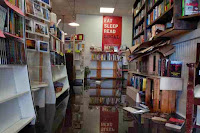Tropical Storm Hermine made landfall close to the city of St. Mark's in Wakulla County, Florida, at about 1.30 am local time on Friday 2 September 2016, the first such storm to make landfall in the state in a decade. The storm was downgraded from a hurricane (storm with sustained winds in excess of 104 km per hour and gusts in excess of 119 km per hour) to a tropical storm (storm with sustained winds in excess of 56 km per hour and gusts in excess of 63 km per hour), shortly before making landfall. Only a single fatality has been attributed to the storm, a 56-year-old man who was killed when a tree fell on the tent he was sleeping in, but widespread flooding has occurred in low lying coastal areas of the state, particularly around the town of Cedar Key, which was hit by a storm surge of 2.9 m, and has left around 70 000 homes and businesses without power in the Tallahassee area..
Flooding in Crystal City, Florida on 2 September 2016. Ed Runyon/The Cutting Edge Photography.
After passing across Florida the storm mover through South and North Carolina, where it has caused further flooding and power outages and where numerous roads have been closed due to fallen trees, and it is predicted to keep moving up the eastern coast of the US as far as Connecticut or New Jersey. No evacuations have been ordered due to the storm, but outdoor events have been cancelled as far north as New Jersey, and sea swimming has been banned in many areas as far north as New York.
Satellite image of Tropical Storm Hermine passing over Florida on Friday 2 September 2016. NOAA.
Tropical storms are caused by the warming effect of the Sun over
tropical seas. As the air warms it expands, causing a drop in air
pressure, and rises, causing air from outside the area to rush in to
replace it. If this happens over a sufficiently wide area then the
inrushing winds will be affected by centrifugal forces caused by the
Earth's rotation (the Coriolis effect). This means that winds will be
deflected clockwise in the northern hemisphere and anti-clockwise in the
southern hemisphere, eventually creating a large, rotating Tropical
Storm. They have different names in different parts of the world, with
those in the northwest Atlantic being referred to as hurricanes.
Despite the obvious danger of winds of this speed, which can physically
blow people, and other large objects, away as well as damaging buildings
and uprooting trees, the real danger from these storms comes from the
flooding they bring. Each drop millibar drop in air-pressure leads to an
approximate 1 cm rise in sea level, with big tropical storms capable of
causing a storm surge of several meters. This is always accompanied by
heavy rainfall, since warm air over the ocean leads to evaporation of
sea water, which is then carried with the storm. These combined often
lead to catastrophic flooding in areas hit by tropical storms.
See also...
 North Carolina suffers flooding but no casualties as Hurricane Arthur hits. Hurricane Arthur swept across the Outer Banks islands of North Carolina
on Friday 4 July 2014, causing flooding and disruption but with no
reports of loss of life or serious damage. Maps of the predicted storm...
North Carolina suffers flooding but no casualties as Hurricane Arthur hits. Hurricane Arthur swept across the Outer Banks islands of North Carolina
on Friday 4 July 2014, causing flooding and disruption but with no
reports of loss of life or serious damage. Maps of the predicted storm... Five family members injured by falling debris as Brooklyn Bridge damaged by Hurricane Arthur. Five members of one family received minor injuries as part of a
facade on the Brooklyn Bridge, New York, collapsed during...
Five family members injured by falling debris as Brooklyn Bridge damaged by Hurricane Arthur. Five members of one family received minor injuries as part of a
facade on the Brooklyn Bridge, New York, collapsed during...  Hurricane Sandy heads towards east coast of America. Hurricane Sandy crossed the Caribbean last week leaving at least 21
people dead, in Jamaica, Haiti, Cuba and the Bahamas. It was...
Hurricane Sandy heads towards east coast of America. Hurricane Sandy crossed the Caribbean last week leaving at least 21
people dead, in Jamaica, Haiti, Cuba and the Bahamas. It was...
Follow Sciency Thoughts on Facebook.


